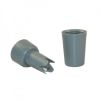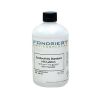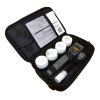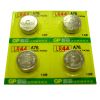YSI EcoSense EC30A Conductivity Pen
Features
- IP-67 waterproof housing
- 1-year instrument warranty
- Automatic temperature compensation
- Expedited repair and warranty service
- Lifetime technical support
- More
With a one-year instrument and electrode warranty, the EC30A will fit your needs for an easy-to-use conductivity, TDS and temperature instrument. The EC30A is a reusable pen-style instrument. The electrode cap is easy to replace while keeping the instrument. No throw-away instrument here!
- IP-67 waterproof housing
- 1-year instrument warranty
- Automatic temperature compensation
- User-replaceable electrodes
- 1- or 2-point calibration
- Clear, easy-to-read display with on-screen instructions
- Selectable units of measure for conductivity, TDS and temp
- Selectable or auto-raning for conductivity or TDS
- "Hold" feature locks readings on display
- >200 hour battery life; low battery indicator
- Last calibration GLP record
- ATC Probe:Thermistor, 10kΩ at 25°C
- Battery:Four LR44 alkalines included with purchase
- Battery life:200 hours or greater (low battery indicator)
- Operating temperature range:0.0 to 50.0 °C (32.0 to 122.0 °F)
- Warranty:1-year instrument and electrode
- Water resistance:IP-67 waterproof case
- Weight:105 grams (3.7 ounces) with batteries
- (1) EC30A instrument
- (1) Conductivity electrode
- (4) Replacement batteries
- (1) Instruction Manual
In The News
What is Conductivity?
UPDATE : Fondriest Environmental is offering their expertise in conductivity through their new online knowledge base. This resource provides an updated and comprehensive look at conductivity and why it is important to water quality. To learn more, check out: Conductivity, Salinity and TDS. Salinity and conductivity measure the water's ability to conduct electricity, which provides a measure of what is dissolved in water. In the SWMP data, a higher conductivity value indicates that there are more chemicals dissolved in the water. Conductivity measures the water's ability to conduct electricity. It is the opposite of resistance. Pure, distilled water is a poor conductor of electricity.
Read MoreMonitoring Habitat Suitability and Water Quality in Northwest Arkansas Springs
Northwest Arkansas has seen an economic, industrial, and population boom in recent years as a result of expanding businesses, which have created thousands of jobs in the region and the mass migration of employees and construction companies. However, with this growth has come rapid urbanization and the degradation of the natural landscape, specifically the freshwater springs that can be found throughout the region. These springs are critical habitat centers for native wildlife, home to threatened and endangered fish, and those that have yet to be listed. Zach Moran, Assistant Professor of Fisheries Science at Arkansas Technical University, is working to help monitor these habitats and provide key data that will hopefully inform future development in the region.
Read MoreThree Decades of Research at Acton Lake
A multi-disciplinary team at Miami University, Ohio, has been studying the environmental change at Acton Lake for over three decades. Using three different NexSens buoys over this time, the team has an incredible archive of data that is helping build a picture of Acton’s past, present, and future. Until recently, a NexSens CB-50 buoy was used alongside other environmental monitoring at Acton Lake. In May 2025, the Miami team deployed a new XB-200 buoy , future-proofing their ongoing monitoring using real-time buoy systems. Acton Lake, a small hypereutrophic reservoir in southwest Ohio, covers 2.4km² and has a maximum depth of about 8m. The dam was built in 1956, and the lake has a large agricultural watershed.
Read More















